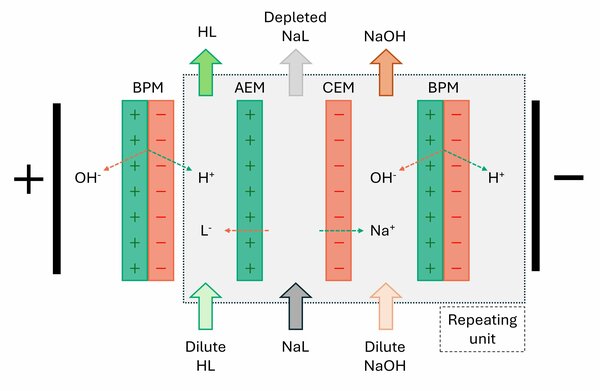The deep removal of CO2 from industrial sources offers a cost-effective approach to achieving carbon neutrality. However, the prevalent use of amine-based CO2 adsorption agents suffers from oxidative and thermal degradation, as well as emissions when increasing the absorber packing height for deep removal of CO2, leading to negative economic and environmental consequences. Aqueous hydroxides present themselves as a promising alternative to amines. However, new electrochemical regeneration processes are required for hydroxide recovery due to their inability for thermal regeneration.
By integrating the water dissociation occurring in the bipolar membrane (BPM) and the conventional electrodialysis, BPM electrodialysis has demonstrated its effectiveness in regenerating acid and base from their corresponding salt solutions. Figure 1 illustrates a typical BPM electrodialysis configuration where sodium lactate (NaL) can be directly converted into its respective acid and base while remaining separate from the generated acid and base stream. In this BPM electrodialysis process, the efficiency of the regeneration relies on the rate of water dissociation. Therefore, it is crucial to develop tailored high-performance BPMs for efficient hydroxide regeneration.
As an integral part of the “Deep Removal of CO2 and InnoVative Electrification Concepts (DRIVE)” project, this study will primarily focus on the design of BPM and the optimization of the BPM electrodialysis process, including materials, stack configuration, voltage, etc. To be specific, the anion exchange layer and cation exchange layer will be fabricated by electrospinning and the interfacial layer containing catalysts will be built by Layer-by-Layer assembly technique. With the BPM developed in this project, we aim at achieving lactic acid production with an energy consumption of 0.14 kWh/kg.

Figure 1. A typical configuration of bipolar membrane electrodialysis in lactic acid regeneration.
Contact information:
Tao Wang
Helix, STO 0.42
t.wang4@tue.nl